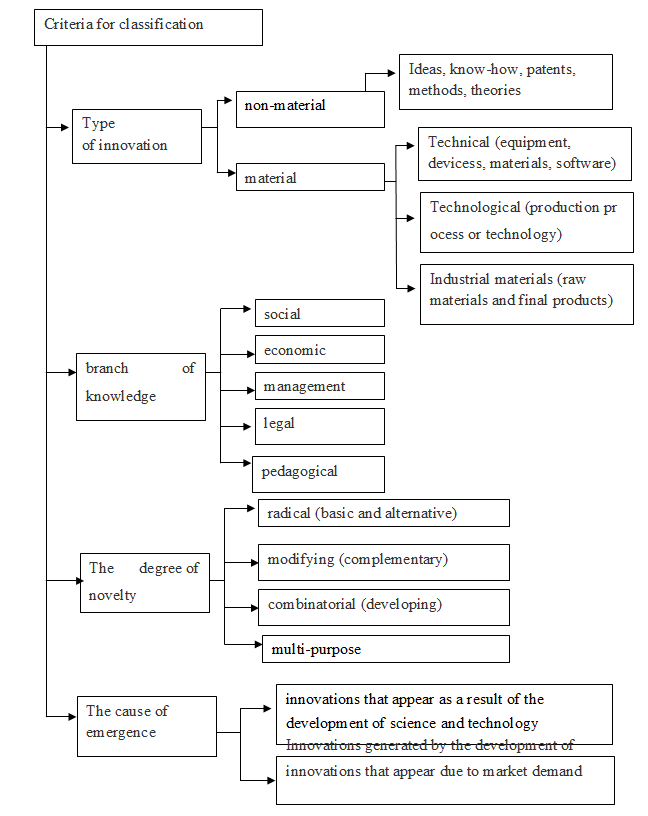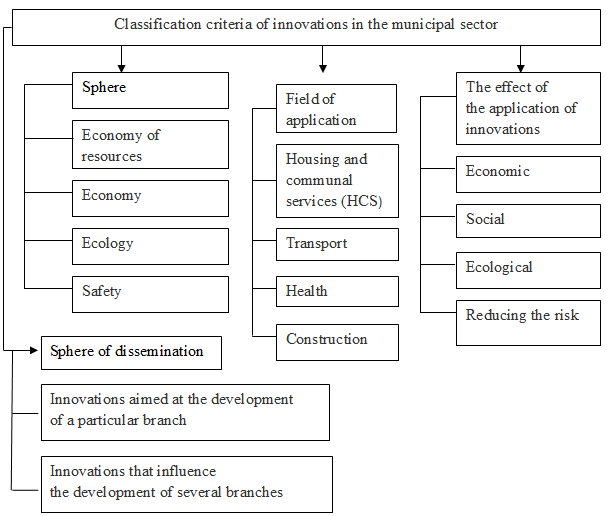Among such trends of the state policy as improving the quality of life, the economic growth, the development of education there is a change to innovative development of our country. After all, innovations not only determine the competitiveness of any successful business, but also the country as a whole. Innovations are an effective means of competition and result in the development of new markets, great investment flows, creation of new products, services and needs. Therefore, only through innovations it is possible to take a strong position on the market today.
Innovation is a novelty applied that provides a qualitative increase in the efficiency of processes or products demanded by the market. It is the final result of human intellectual activity, his imagination, his creative process, discoveries, inventions and rationalization.
Innovation is not just any new thing or novelty. It is only one which seriously increases the efficiency of the existing system. [1].
The term "innovation" is closely related to such terms as "discovery" and "invention." A discovery is the process of obtaining the previously unknown data. An invention is new instruments and mechanisms created by man. The main difference between innovation and discovery is that the discovery is not intended to benefit.
Everything, even the most advanced technologies, products, services, with a few exceptions, have a limited life. This period is called the "life cycle". The life cycle of an innovation is a certain period of time during which the innovation has an active vital force and brings the manufacturer and / or seller some profit or other tangible benefits. The life cycles of an innovation vary by type of innovations. These differences affect, above all, the total duration of the cycle, the duration of each stage in the cycle, particularities in the development of the cycle itself, the different number of stages. The types and the number of stages in the life cycle are defined by the features of a particular innovation. [2, с. 60]. Schemes of the life cycle of an innovation product and an innovative operation are different (Table 1).
Table 1 - Stages of the life cycle of a new product and a new operation
|
The life cycle of a new product |
The life cycle of a new operation |
|
1.
new product development; |
1. development
of a new operation and processing it into a
document; |
At the stage of the development of a new product the manufacturer organizes the innovation process. Actually, it is the stage of the investment of capital. Entering the market is the period of the introduction of a new product to the market. The product starts to make money. The duration of this stage depends on the intensity of advertising, the level of inflation and the effective work of centres that sell new products. The stage of the market development is the stage of the increase in the sales of the product on the market. This is the period of time, during which the new product is actively sold and the market reaches a certain point of saturation with this product.
The stage of stabilization of the market means that the market is already saturated with the product. The volume of sales has reached a particular limit, and there will not be any further growth in sales.
The stage of decrease in the market is the stage, at which there is a decline in the sales of the product, but there is still a demand for it and, therefore, there are all the objective prerequisites for the increase in the product sales. The last two stages may be only in the diversification of the market.
The recovery of the market is a continuation of the previous stage. Once there is a demand for the product, the manufacturer begins to study the conditions of the demand, change its pricing and personnel policy, use various forms of incentive product sales for a seller (premium) and a buyer (prizes, discounts), carry out additional activities. All these allow the manufacturer or the retailer to increase the sales of the product for a certain period of time. The stage of the recovery of the market continues for a short time and goes into the final stage - the stage of the market decline.
The stage of the falling market is a sharp decline in the volume of sales of the product, that is, its drop to zero. At this stage the product is completely sold or there is a complete cessation of sales of the product because there is no demand for it among customers.
Let us consider the life cycle of a new operation. During the development of a new operation and processing it into a document the work is done on the initiation, search for ideas, development of the entire algorithm of the financial operation, creation of the document. At this stage, the manufacturer is funding all costs to develop the operation.
The stage of implementation of the operation is the period of active promotion and dissemination of the innovation. The stage of stabilization of the market shows a saturation of the market for this operation and goes into the stage of falling market, when sales of the operation begin to decrease sharply until the complete cessation of the sale.
We can speak about an innovation only if it is introduced in the market or in the production process. For an innovation such properties as scientific and technological novelty, industrial applicability and commercial feasibility are equally important. The lack of any of these properties will negatively affect the innovation process.
In the course of studying innovations their classification features and various systems of their classification were defined.
Classification of innovations is their organization in specific groups according to certain criteria. The creation of a classification scheme of innovations begins with the definition of classification features. Classification feature is a distinctive feature of a particular group of innovations, its main feature. Innovations can be classified using different schemes and different classification features. In the economic literature there is a variety of approaches to the classification of innovations, as well as to the selection of its criteria.
The author studied in detail and elaborated the classification of innovations by Egorova N.E [3, с. 2].
The main criteria for this classification are:
the type of the innovation
a branch of knowledge
the degree of novelty
the cause of emergence
According to the type of innovation, first of all we speak about non-material and material innovations. Non-material innovations are ideas, know-how, patents, methods and theories. Material innovations are equipment, devices, production process and technology, raw materials and final products. According to the branch of knowledge there are social, economic, management, legal and pedagogical innovations. According to the degree of novelty there may be radical, modifying, combinative and multi-purpose innovations. According to the cause of emergence there are innovations that appear as a result of the development of science and technology due to the market demand (Figure 1).
Figure 1 - Classification of innovations
At present a great number of innovative projects are aimed at the solution of the problems and improvement of work of municipal services.
For effective development of municipal services it is necessary to apply innovations in their every branch. Priority should be given to the innovations, which, when applied, are effective for several branches of municipal services.
The effect of the application of innovations in the municipal sector may be economic when money is saved and there is additional revenue from implemented innovative projects, ecological, which is confirmed by the measurements and conclusions of the controlling bodies of the environmental organizations, and social as it motivates people to improve the quality of life, that is to increase incomes, create jobs, develop culture. The effect can also be expressed in reduced risk.
The author developed classification of innovations for municipal services. (Figure 2). The main criteria for the proposed classification of innovations are:
- the field of application
- the effect of the application of innovations
- the sphere of dissemination of innovations
- sphere
Figure 2 - Classification criteria of innovations in the municipal sector
Innovative development of the municipal services is based on the application of the results of scientific and technological progress making use of scientific developments (manufacture of new products, application of new technologies, etc.), which result in qualitative changes in social, economic and environmental fields.
n the long term without innovations there may not be any further intensive economic and cultural development.
References:
- Electronic resource: http://ru.wikipedia.org/wiki free encyclopedia
- Innovation Management and the State Innovation Policy - a tutorial, Agarkov S.A, Kuznetsova E,S., Gryaznov M.O., Ed. "The Academy of Natural Science," 2011.
- Bank audit. Venture Capital in Russia and the Funding of Advanced Technologies and knowledge-intensive industries. -Egorova N.E., Smulov A.M., Inozemtsev V.V.








